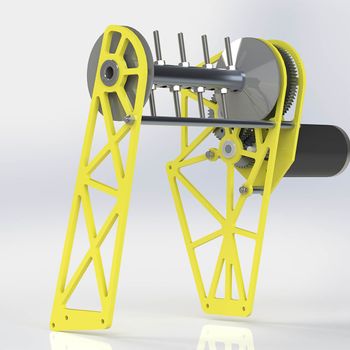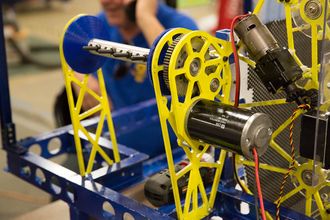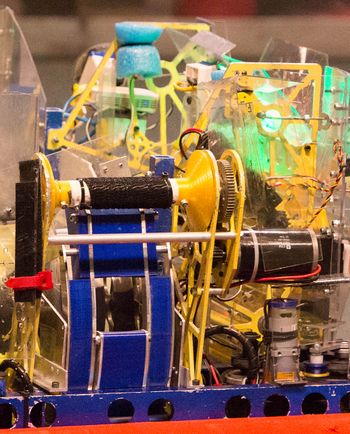Difference between revisions of "DEWBOT XIII Rope Climber"
MaiKangWei (talk | contribs) (→Rope) |
MaiKangWei (talk | contribs) (→Ratchet) |
||
| Line 28: | Line 28: | ||
==Ratchet== | ==Ratchet== | ||
| + | A flex-ratchet wrench was employed to prevent back-drive of the climber. 3/8" initially; later 7/16". This was mounted on the non-driven end of the climber spool. The wrench is held in place by a pin, which may be removed to facilitate lowering the robot. | ||
==Rope== | ==Rope== | ||
Revision as of 12:54, 7 May 2017
At 50 points per robot, SteamWorks' endgame climb is in no way optional. Climbing makes up a large portion of a typical match's total score and in light of this, having a robot on your alliance missing a climb generally means that your alliance loses.Key climber requirements are:
- Reliability - The climb needs to work every time
- Speed - The climb needs to take <10 sec including engagement. Robots having faster climbs are able to continue scoring longer or delay slow-climbing robots from reaching their ropes
- Shouldn't back-drive
- Don't fall! (it hurts & you lose)
Contents
Climber
A number of approaches were prototyped, before designing and developing DEWBOT's climber. The original iteration of the climber comprised an 8" long, 1" diameter aluminum tube having nine 1/4"-20 bolts set at 180 deg and staggered. The bolts engaged loops in our rope, and once engaged, the robot climbed. Printed flanges at the tube ends constrained the coiling rope and kept it from fouling the bearings.Engaging the loops with the bolts proved too unreliable and slow in practice. After Seneca, the bolt/loop system was replaced by Velcro. In making this change, we clad the aluminum tube with 1" PVC pipe (1.315 in OD) around which adhesive-backed hook Velcro is wrapped.
The climber was designed to mount on the robot superimposed over the shooter, making it space-efficient. Support plates for the climber and it's gearbox were cut from 3/16" 6061 Al using a CNC router.
Powerplant & Gearing
- A 12 tooth pinion (Vexpro 217-3099) driving a 34 tooth gear (Vexpro 217-3211), the 34T gear being coaxial with
- A 14 tooth gear (Vexpro 217-3100) driving a 54 tooth gear (Vexpro 217-3220), the 54T gear being coaxial with
- A 16 tooth gear (Vexpro 217-5450) driving a 70 tooth gear (Vexpro 217-3224), the 70T gear being coaxial with and directly driving the climber spool.
The above gearing was consistently reliable, but time from rope contact to light on is 8±1 second.
At FRC Championship, the 3rd stage gears were changed to 26 tooth (Vexpro 217-5453) and 60 tooth (Vexpro 217-2714), changing the gear reduction to 25.2:1, thereby speeding the climb.
All gears are 20 DP (diametrical pitch) with 14 degree contact angle. All gears larger than 14T are 7075 Al for weight consideration. I note that Vexpro has introduced an extremely useful line of 20 DP 14 deg 7075 Al spur gears.
Ratchet
A flex-ratchet wrench was employed to prevent back-drive of the climber. 3/8" initially; later 7/16". This was mounted on the non-driven end of the climber spool. The wrench is held in place by a pin, which may be removed to facilitate lowering the robot.
Rope
Our first rope concept was braided shark string. While strong, shark string is very thin and it is likely that it would not have held up to the sharp angle on the davit very well. The braiding process was very laborious. Braided shark string was abandoned during build season.
Our rope at Westtown was standard 1/4" nylon rope with loops. This rope broke at the davit angle during two climbs.


